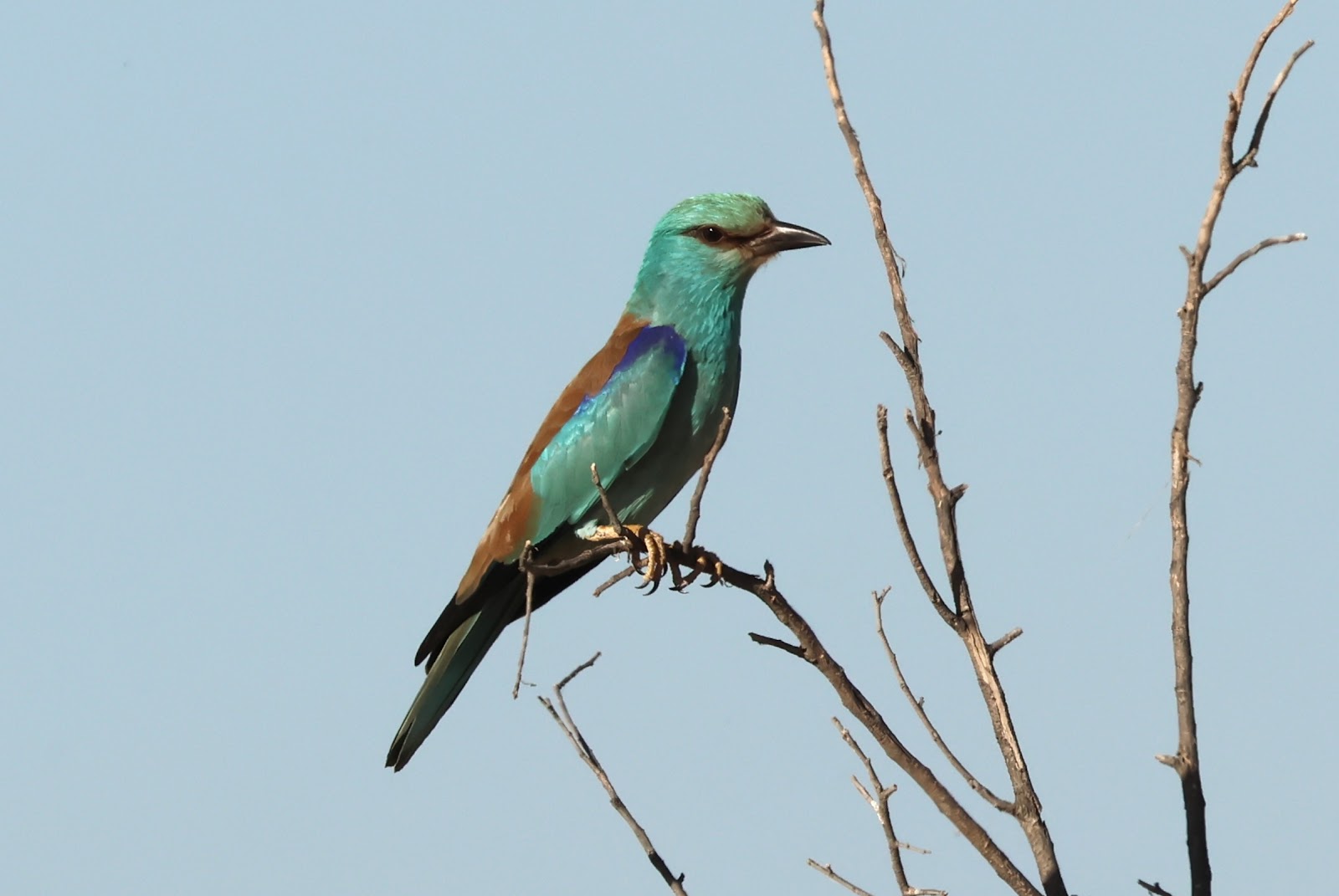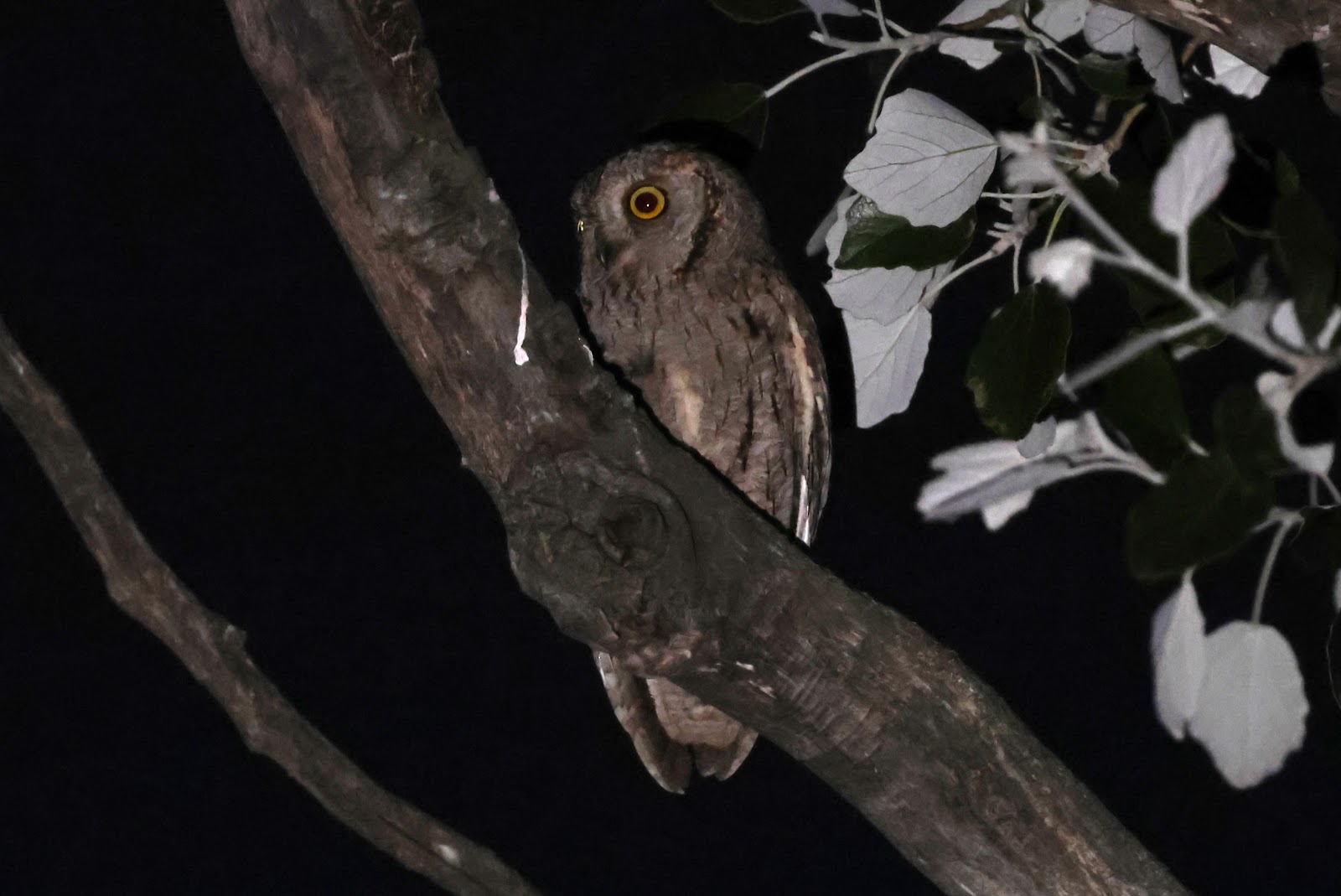After picking up Paul, we headed NE towards Zaragoza. One of the key target species for this part of the trip was Dupont’s Lark. This was a new species for Paul, but one I had seen in Morocco back in 1988. Despite my failure to see the species in Spain in 1984, I had a high degree of confidence that we would see one, based on the frequency of sightings at the main site. The expression “pride comes before the fall” was soon to come to mind!
We made a quick stop near Sauca on the drive north as this was the nearest area where Dupont’s was possible. After about 10 minutes of driving around, we found suitable habitat and began to search. To a background of singing skylarks, we found Black-eared Wheatear, Iberian Gray and Woodchat Shrikes, and Tawny Pipit. There was no sight or sound of Dupont’s Larks and after sunset we headed north to our hotel.
I had been ignoring several Whatsapp calls on my phone, assuming them to be spam. On arrival at our hotel, we found no one at reception. Getting around to checking my Whatsapp, I found the hotel had been trying to contact me. After a quick exchange of texts, we got hold of the room key from a lock box and I sent a photo of my passport to complete the check-in. It was well gone 11 PM at that point and the remote reception then signed off, telling us to call if there any issues. A minute later, we did indeed find an issue – the room key did not work! After a couple of calls went unreturned, we started scavenging around the hotel for sleeping essentials. Fortunately, the linen rooms were unlocked and we were able to find a couple of mattresses as well as sheets and pillows. We set these up in an alcove near the reception where the bathrooms were. Beds and “ensuite bathrooms” – what more could we want! Well, fewer bright lights. About 30 minutes after settling down, I got a call from reception. Frankly, I was so tired I was happy to stay where we were but we told how to get the master key from another lock box and this time were able to get into our room. By now it was past 1 AM. We had to get up by 5.00 AM the next morning to get to the Dupont’s site by sunrise to maximize our chances of hearing one singing. Needless to say, I didn’t sleep that well.
The next morning we set out in the dark to drive to the nature preserve of El Planeron, a well-known spot for Dupont’s Lark. Upon arrival at the area, I was surprised to see that it was mostly extensively agricultural fields with limited areas of natural habitat. We searched some of these in vain for a sight or sound of a Dupont’s Lark. In retrospect, we probably should have stopped at multiple stops along the road and listened for the lark. However, despite this being a reliable area, I think having more specific knowledge of exactly where they are would have been very helpful.
Calandra Lark (by Paul Thompson)
Paul needed to see many other lark species and we were successful in seeing Calandra, Lesser (Mediterranean) and Greater Short-toed Larks well.
Lesser (Mediterranean) Short-toed Lark (by Paul Thompson)
In addition to the lark show, there were plenty of sandgrouse showing, mostly in flight but several rather well on the ground in ploughed fields. The sandgrouse were overwhelmingly Pin-tailed, with over 30 estimated, but there were a few Black-bellied as well. Paul missed the latter, but Pin-tailed was the key species as he had never seen one before.

Pin-tailed Sandgrouse (by Paul Thompson)
A couple of (Red-billed) Choughs were a surprise, although it transpired that this species is quite widespread in the dry lowlands in the area. Another target species was Spectacled Warbler. We found a pair of these in a large patch of thistles but it was frustratingly difficult to get good looks. El Planeron includes a vernal wetland with some reedy fringes. We heard both Reed and Great Reed Warblers here, but failed to see the latter. Other species included Tawny Pipit, the Iberian race of Yellow Wagtail, and both Woodchat and Iberian Gray Shrikes. An abandoned, dilapidated farm building held the inevitable Little Owl. Raptors were pretty limited with just a Short-toed Eagle and a Marsh Harrier seen.
After a brief stop another nearby reserve, where the habitat looked rather more extensive for Dupont’s Lark, we drove the over one and half hours to Lleida. We checked into our hotel and waited a couple of hours for the baking heat to begin to subside. We then headed to Secans Belianes-Preixana, an agricultural area now known to be one of the more reliable places to see Little Bustard this late in spring.
We set about systematically driving the side roads and scanning for birds. We soon began to see various larks before the first Rollers for Paul’s section of the trip appeared.

European Roller (by Paul Thompson)
Although checking the various sparrow flocks, failed to turn up any Spanish Sparrows, we did see (Eurasian) Tree Sparrow and then a big bonus with the first Rock Sparrows of the trip, which were feeding along a track at the edge of an orchard. A little further down the road, Paul picked out a smaller harrier. We stop the car and jumped out and had nice looks at a male Montagu’s Harrier.

Montagu’s Harrier (photo by Paul Thompson)
We also noticed a few hunting kestrels, at least a couple of which were clearly Lessers. While trying to sort out the kestrels, I picked three larger birds with fast wing-beats flying towards me. Initially thinking they were some kind of duck, I saw that they had white forewings. It suddenly clicked they must be Little Bustards. I drew Paul’s attention to them and the birds flew by giving decent looks. Two continued to fly away, but the third, a male, doubled back and and gave us very good flight views in perfect light.
After that success, we continued driving around the dirt roads, discovering the Lesser Kestrels were breeding on an abandoned house. We also saw a couple more Montagu’s Harriers.

Male Lesser Kestrel (photo by Paul Thompson)
Having bagged the key species at Secans Belianes-Preixana plus a bonus in Rock Sparrow, we head back to area just south Lleida for some night birding.
Almost immediately after sunset, we heard a European Scops Owl calling, but the bird was unresponsive to playback. Feeling confident that situation would change after dark, we wandered a bit further to look for Red-necked Nightjars. After a short wait, while the light was still quite good, we heard the first nightjar and had excellent flight views of these largish nightjars.
By the time we had finished enjoying the nightjars, it was fully dark and time to give the owl another try. We initially tempted it into a pine tree, but were unable to visually locate despite the close range. Deciding the pine trees were too dense, we decided to try to move the owl into a partially dead tree in the riparian tree. This strategy worked out well and we soon had good looks. We were very pleased at bagging the two key night birds – both new for Paul – at the first attempt.

European Scops Owl
Given that we had a six-hour drive the next day back to central Spain, we only had a few hours the next morning. That evening we looked at our options and decided to try an area right by the nightbird site early in the morning that had at least one Dupont’s Lark. We then found another area northwest of Lleida that also held Dupont’s Larks and also seemed pretty good for Great Spotted Cuckoo. It was a large area and not possible to workout from ebird where the birds were being seen. We would just have to work out a good spot once we could see the lay of the land.
Arriving at the initial spot around dawn failed to reveal any singing Dupont’s Larks. Since the other species present were all ones we had been seeing the previous day, we decided to move on to the second area. This area consisted predictably of mostly agricultural fields and after some driving around we reached a small ridge we could scan the surrounding area from. Noticing an area that seemed to have the natural thyme-based heathland and some addition low trees and bushes, we headed over there. Once we arrived, it was clear that there was a decent-sized chunk of Dupont’s Lark habitat that we proceeded to give a thorough going-over.

Thekla Lark (by Paul Thompson)
At this point, we had not seen a convincing Thekla Lark since Paul’s arrival but the natural heath here seemed to offer a good opportunity. After a while, we were able to see good candidates perching up in bushes, a purported Thekla trait. Closer study showed the birds to have shorter bills with a convex lower mandible.
A nice mixed flock of Jackdaws and Choughs flew by and a distant raptor proved to be an immature Golden Eagle, our first of the trip. After glimpsing a Spectacled Warbler, we followed up, hoping to get improved looks on the previous day. With some persistence, we were saw both the male and female well. It was nice to see how different the male was from a Whitethroat, with dark lores, an extensive pink flush on the upperparts and more extensively rufous wings and tertials. While viewing the Spectacled Warblers, our attention was drawn to a Black-eared Wheatear mobbing a larger bird – a Great Spotted Cuckoo! This gave great looks and eased the pain of failing to catch up with a Dupont’s Lark.

Great Spotted Cuckoo (by Paul Thompson)


Comments
Post a Comment